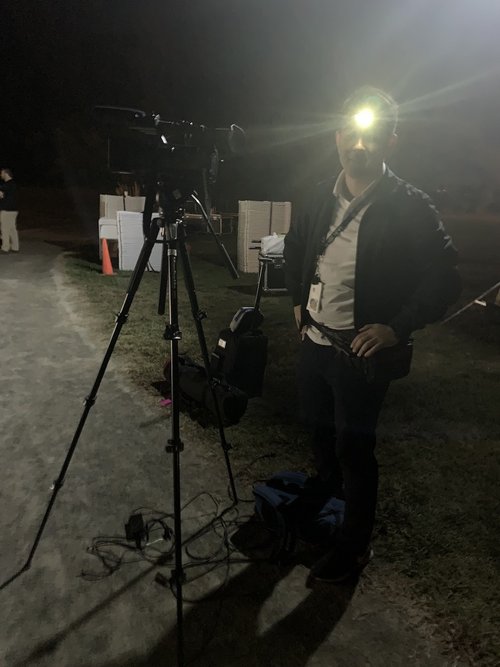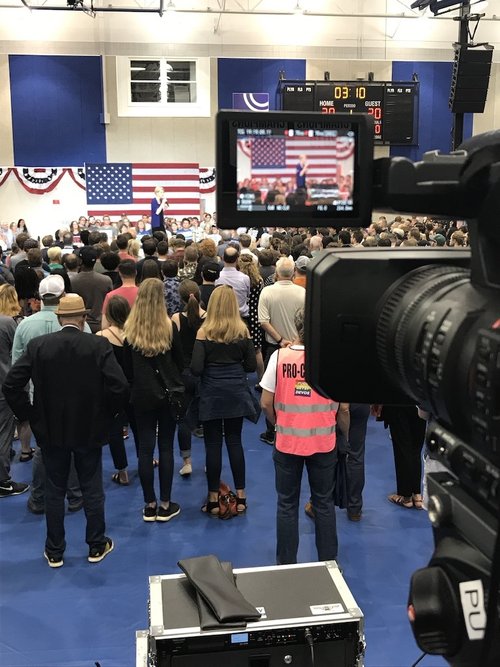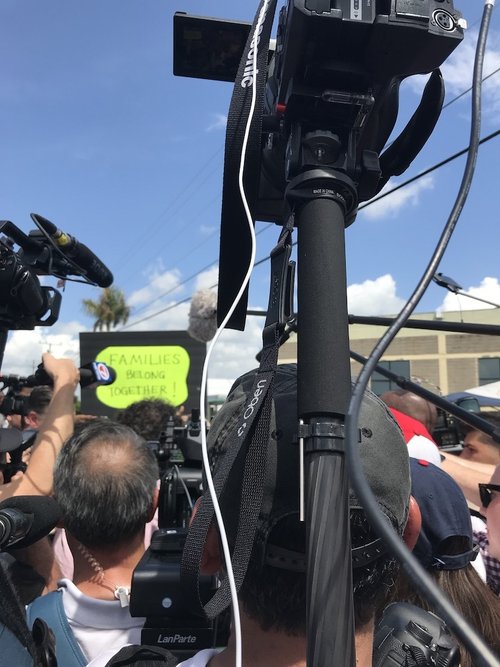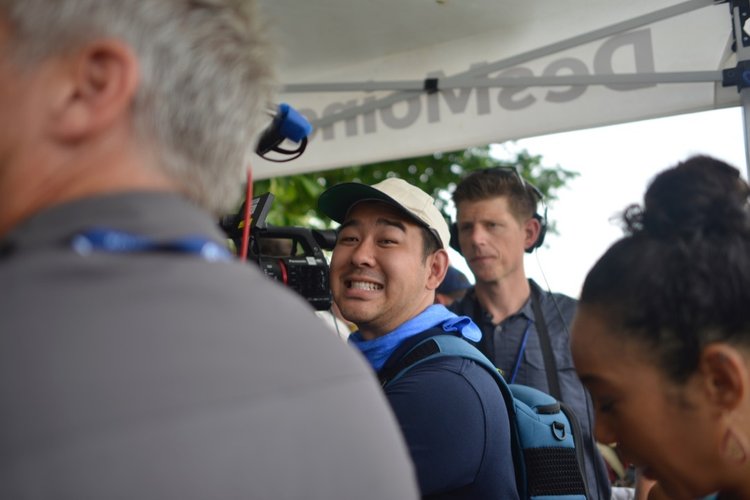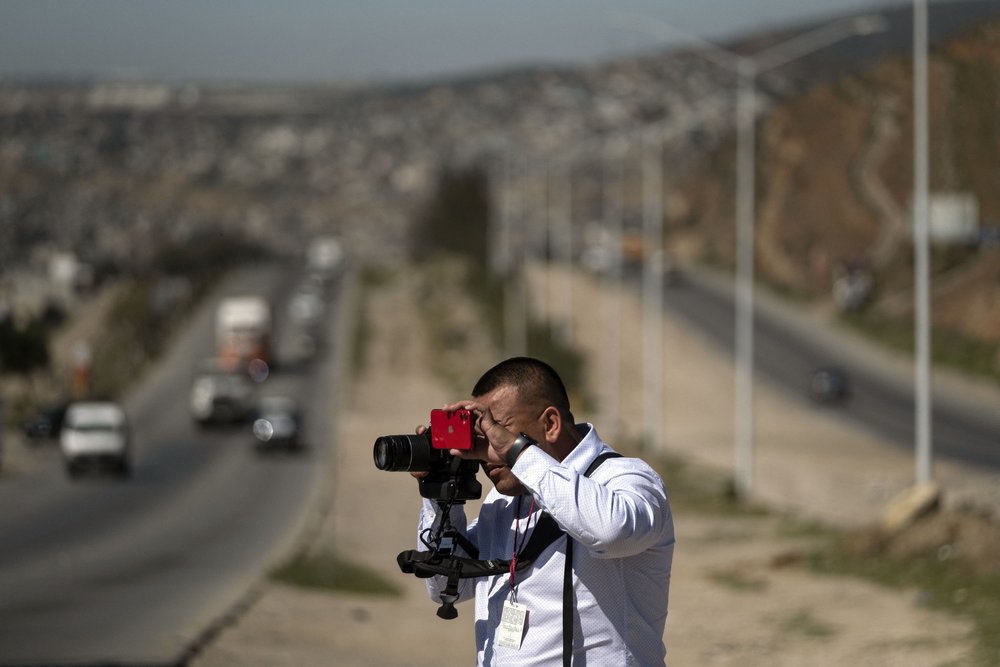
Few roles embody the modern newsroom — in its advances and demands — more than the multimedia journalist.
Known as “one-man bands” or “backpack reporters,” MMJs often roam the field alone, assuming the responsibilities — and carrying the gear — of four people: writer, broadcaster, cameraperson and editor. They are often the first on the scene to deliver scoops, whether it’s a campaign development, a protest or a weather event, producing some of the most visually arresting journalism on the internet.
They also frequently face life-threatening situations.
Earlier this year, Tori Yorgey, a breaking news reporter for a West Virginia TV station, was struck by a car while reporting at the scene of a water main break — and then kept on reporting. Last summer in North Carolina, a man stole a car from a TV reporter and video journalist shortly after they wrapped a live report, eventually crashing into a police cruiser.
Former President Donald Trump’s diatribes against the media and the rise of fringe movements in recent years have not helped. MMJs covering right-wing protests have been arrested, assaulted, pepper-sprayed and robbed at the hands of demonstrators and police. According to a Radio Television Digital News Association survey of more than 1,700 nonsatellite stations, 1 in 5 television news directors said their crews had been attacked at some point last year.
For interns and entry-level journalists, an MMJ position can be a crash course in fundamental reporting skills, said Benjamin Pu, a producer for NBC News’ Diversity, Equity and Inclusion team. As a campaign-embedded reporter in 2020, he learned how to shoot interviews and live shots using a camcorder and other industry-standard equipment.
“People need to understand that the expectation for multimedia journalists is that they go out and they do everything themselves, and that can be a great benefit to someone who is learning,” Pu said. “But it’s also worth remembering the downsides: It’s not necessarily a way to make a big buck, the job is also very hard, and there’s street harassment. People don’t always understand these factors until they get on the job.”
How much risk is too much?
The digital transformation of local and national newsrooms has increased demand for multimedia storytelling, particularly in breaking news. In the past decade or so, young MMJs have become a dominant presence in the media landscape, with many hired straight out of college. According to ZipRecruiter, the average MMJ in the U.S. makes around $50,000 a year, about $5,000 more than an entry-level reporter but with the heightened risk and responsibility of multiple jobs.
Tim Furlong, an Emmy-winning multimedia journalist at NBC10 Philadelphia, said having the artistic freedom to craft a story from beginning to end is the most rewarding part of his work.
“You have to be a Swiss Army knife,” he said, noting that he uses a drone and GoPro camera to scout out locations and capture footage. “I love the control and creativity of shooting on gear I want to shoot on.”
At the same time, Furlong said he has dragged overly eager young reporters out of political rallies that have turned violent. Julio-Cesar Chavez, a multimedia journalist at Reuters and vice president of broadcast at the National Association of Hispanic Journalists, said he saw many freelance MMJs without any protective gear when he was covering the George Floyd protests in 2020. He himself was struck by a tear gas canister at one point but was spared serious injury by a bullet-proof vest Reuters had provided.
“We all know that the MMJ position is nothing more or less than a cost-saving measure,” he said. “But when managers are sending people out to dangerous situations, they really need to send a support team.”
For years, MMJs were mostly a small market phenomenon, which meant reporters went out alone, sometimes without safety and de-escalation training. But in recent years, as more national stations hired MMJs to cut costs, news directors have become more cognizant of the risks.
According to a survey by the Radio Television Digital News Association last year, 86% of news directors have adopted at least some new practices to protect employees, such as purchasing bullet-proof vests and gas masks and more often sending security teams with reporters. After Yorgey was struck by an SUV, MMJs called for greater industry-wide protections. In October, the Society of Professional Journalists published safety guidelines for newsrooms that use MMJs, including discontinuing solo live shots at night, identifying a go-to person in the newsroom for safety concerns and establishing safety barriers near traffic and crowds.

But even when a news event doesn’t meet the danger level required for sending along a support team, problems can occur. Many women, more often than not, face elevated risks of reporting alone in the field. A clip of New York TV reporter Brianna Hamblin being harassed as she prepared to go on air went viral on YouTube.
Sarah Blake Morgan, a former multimedia journalist for The Associated Press in Charlotte, North Carolina, said sexual harassment just comes with the job.
“People think it’s OK to say whatever they want online and in person,” she said. “The messages I’d get on Twitter or Facebook are wild — people criticizing the way I wear my hair, or how much blush I had on that night.”
A multimedia journalist at a major national outlet, who asked to be anonymous because she’s under contract negotiations, said that fending off unwanted advances from men is a habitual experience she’s “begrudgingly become accustomed to.
“Often, it’s people saying, ‘I don’t want to be interviewed, but what’s your number?’” she said. “You just have to smile and nod and not engage and get yourself out of the situation.”
MMJs are taking their safety into their own hands
Some MMJs can’t afford to wait for newsrooms to add better safety protocols; they’re taking precautions on their own.
During protests against police violence the past couple of summers, Chavez said he paired with a photographer or writer from another outlet to look out for each other.
“My philosophy has always been that I leave the majority of the competition to management,” he said. “But when it’s two reporters from different stations assigned to the same story, there’s no real big loss to working together.”
Chavez provides his editors timely updates on WhatsApp and always shares his live location while shooting on scene. When there’s a risk of arrest, he said MMJs should make sure friends and family members save the news director’s number on their phones — because police typically call loved ones first. Chavez also encourages young MMJs to prioritize safety over story, and to speak out if they feel uncomfortable covering an event without backup.
“Don’t be afraid to leave,” he said. “You don’t have any other obligation to engage with people.”
To help others deal with harassment, Morgan founded the Facebook group MMJane. The support group of thousands of female MMJs features lengthy discussions and advice about work challenges. One woman reported receiving a barrage of texts and FaceTime calls from a stranger who found her email on Instagram after seeing her on TV. People suggested putting a different email account on social media that isn’t linked to her FaceTime and phone number.
Morgan, who’s now freelancing while training to be an Army Reserve officer, said she’d share her location with her husband or colleagues at the news station when she went door knocking. Most importantly, she said, know your boundaries and ask for backup when you’re in unpredictable situations. It’s a job, like many, where you have to learn to be your best advocate.
“When you’re 24 and in a bigger market, you don’t want to give the impression that you can’t handle it,” she said. “But it’s important to stand up for yourself in the newsroom, or you will get run over.”
Gallery: MMJ on the Campaign Trail
NBC News’ Benjamin Pu shares photos from covering the 2020 presidential campaign on his own.



